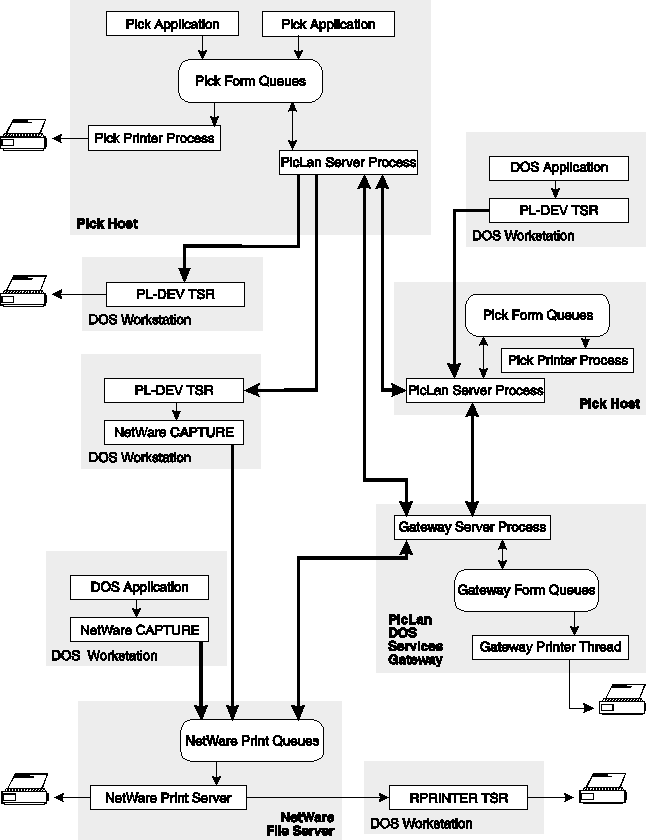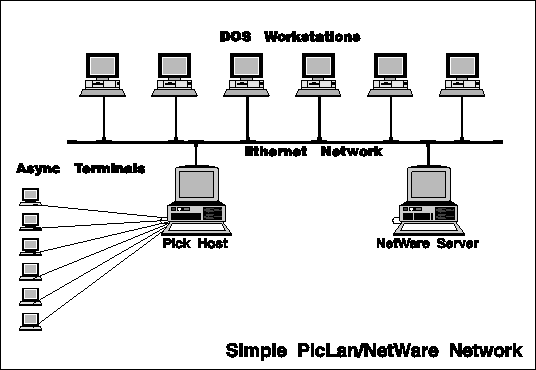PicLan - Networking for Pick
(C) Copyright 1990-1998 Modular Software Corporation. All rights reserved.
Version 2.0.0.17 - February 28, 1998
Goto: Table of Contents Index
Chapter: 1 2 3 4 5 6 7 8 9 10 11 12 13 14
A PicLan network consists of one or several Pick host computer systems connected to a network. DOS workstations may also connect to the PicLan network.
- ETH
- PicLan host computer systems connect to Ethernet networks using PicLan Ethernet network interface controllers. PicLan network interface controllers are available for thick-net/thin-net/cheaper-net or twisted-pair Ethernet cabling. PicLan Ethernet networks may be interconnected to non-Ethernet networks by using NetWare routers.
- UPB
- PicLan host computer systems connect to Ethernet networking utilizing PicLan Ethernet network interface controllers. PicLan host computer systems can also connect to Ethernet and other networks using NetWare compatible network interface controllers in conjunction with DOS IPX driver software.
- R91
- PicLan host computer systems connect to ArcNET networks using General Automation ArcNET network interface adapters. PicLan ArcNET networks may be interconnected to non-ArcNET networks by using NetWare routers.
PicLan network functions are compatible with Novell NetWare IPX packet format protocols and are fully operational over NetWare routers. In addition, DOS workstations may use NetWare shell programs to interface with workstation network interface controllers while using PicLan programs and functions.
Windows 95 and Windows NT are multi-protocol network clients. Each platform includes protocol stacks for NETBEUI, TCP/IP, and IPX. PicLan is fully compatible with the 32-bit networking layers included in Windows 95 and Windows NT.
PicLan uses a hardware-level IPX network protocol for it's operation. IPX is used most commonly by Novell NetWare networks. Most other DOS-based networks due not use IPX as their core protocol and will not work with PicLan without special configuration at the DOS workstation. In configuring PicLan to operate with a non-IPX based network, each DOS workstation must be configured to support more than one network protocol simultaneously. Functions within the PicLan DOS support drivers allow PicLan to operate with a number of DOS networking driver specifications including:
- IPX drivers
- Direct WD8003/8013 Ethernet adapters
- Direct NE2000 Ethernet adapters
- Direct DEC 21x4x PCI Ethernet adapters
- Packet-Driver Ethernet drivers
- Packet-Driver ArcNET drivers
- NDIS Ethernet drivers
This wide range of interface choices allow PicLan to function with most DOS networks, although there may be configuration issues that make some networks easier than others. In addition, some PicLan functions (such as printer re-direction) may be specifically targeted at certain networks, so these functions may not be available with other networks that implement printing differently.
PicLan provides several networking functions previously unavailable to Pick-based systems. These include:
Users may use Pick terminal sessions (the equivalent to an async login connection) from any system on the network (either DOS or Pick). Thus a DOS user may login to a Pick system using the network as an interconnection medium. In addition, a Pick user (even an async user) may login to a second Pick host system using the network as an interconnection medium.
Network terminal sessions feature:
- Extremely fast data transfer rates
- Reliable connections
- Multiple simultaneous connections (for both DOS and Windows users)
- Pick port contention
- Windowed terminal interface
DOS terminal users may use either one of the PicLan terminal emulators (PL-TERM.EXE or PLT.EXE), or 3rd-party terminal emulation programs such as TERMiTE, Via Duct, and AccuTerm which have integrated PicLan support into their packages. Windows users can select from 16-bit and 32-bit Windows applications (PLTW.EXE or PLTW32.EXE), or 3rd-party terminal emulation programs such as wIntegrate, TERMiTE for Windows, WinLink and others. For information on using these other products over a PicLan network, consult the appropriate package's documentation.
Users may use PicLan functions to transfer files between systems on the network. This includes transfers between multiple Pick systems and between Pick and DOS systems. This allows integration of multi-machine data processing functions in a network environment. PicLan file transfer functions also feature fully error-corrected operation as well as data transfer rates that are typically several orders of magnitude faster than serial transfers.
PicLan includes programming libraries that can actually allow application to have on-line access to files that are stored on remote systems.
Users may use PicLan printing functions including remote spooling from one Pick system to another, printing from DOS to Pick, printing from Pick to DOS attached printers, and spooling from Pick to the NetWare print-queue system. This allows network users flexibility in printer placement and configuration within a network environment.
The PicLan system is licensed in differing ways of different host platforms. On some platforms, PicLan is bundled with the base O/S release. On other platforms, PicLan is licensed as available or not available. Other platforms are licnesed based on the end-user configuration and requirements. The PicLan software package always includes all of the PicLan components. License limits on the use of these components are then placed on the system based on the PicLan authorization code procedure (described below). In general, a PicLan license consists of the following elements.
All PicLan systems include a base license component. This component provides for installation of the PicLan host software onto a single Pick computer system and connection of that system to a network. The base license also provides for installation of PicLan utility software on DOS workstation systems as required in support of the host Pick system.
The base PicLan license includes the following functions:
- DOS terminal emulation functions from a single DOS workstation.
- DOS file transfer functions from any number of DOS workstations.
- DOS print redirection functions from any number of DOS workstations.
The base PicLan license can be extended to support additional numbers of DOS terminal users. These users are licensed as to the maximum number of workstations that may be connected to a Pick host system at any one time. In that each user may connect to multiple Pick ports simultaneously, the number of users may be considerably lower than the number of Pick network ports that are used.
An optional component (on some platforms) of the PicLan package is the DOS Services Gateway. The DOS Services Gateway is a workstation program that is used by PicLan to perform several Pick to DOS file transfer and printing functions. These functions include:
- Pick initiated file transfer functions.
- Pick remote access of DOS files through subroutine calls.
- Pick spooler printing to DOS devices.
- Pick to NetWare print spooling functions.
The DOS Services Gateway is a software program that executes a DOS workstation. There are currently three versions of the DOS Services Gateway program:
- PL-DSG.EXE - stand-alone dedicated DOS program
- PL-TERM.EXE - stand-alone dedicated PicLan terminal emulator and DOS Services Gateway program.
- PL-DSGW.EXE - 16-bit windows program.
- PL-DSG32.EXE - 32-bit windows program
Another optional component of the PicLan package (again on some platforms) is the ability to connect multiple Pick systems together on a network. For Pick to Pick connectivity, each Pick host system must be licensed for PicLan and each system must have the Pick to Pick option enabled. Pick to Pick provides the following network functions:
- Remote login from one Pick system to another.
- Remote copy of data from one Pick system to another.
- Remote proceedure calls (RPC) allowing you to call Pick BASIC subroutine residing on a remote system.
- Remote access of Pick files stored on another system through Pick subroutine calls.
- Remote spooling of print jobs from one Pick system to another.
Pick to Pick functions are available even when the networked Pick systems are from different vendors. Since some PicLan implementations use different network cabling systems, in some cases networking different Pick platforms together is impossible without the use of IPX routers.

Goto: Table of Contents Index
Chapter: 1 2 3 4 5 6 7 8 9 10 11 12 13 14


